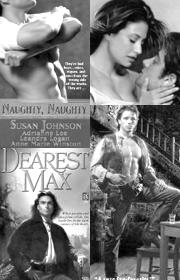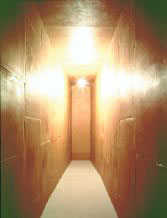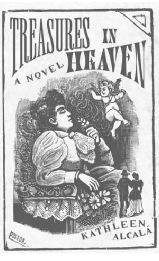“A city without desire is . . . a city of no imagination.”—Ann Carson, from Eros the Bittersweet
YOU’D HAVE THOUGHT I’d infiltrated a Victoria’s Secret photo shoot or journeyed deep into the jungle to finally make contact with The Last Remaining Unspoiled Tribe. What do they look like? Are they intelligent? Do they seem different from you and me? Friends who had never before evinced the slightest interest in my writing suddenly bombarded me with questions. I had knowledge no one else possessed. I had been to the edge and back.
I had attended a romance writers’ conference.
Hundreds of local chapters of the Romance Writers of America hold conferences every year, and in February the Kitsap Peninsula chapter—awash in talented authors, I’d heard—held theirs at the West Coast Silverdale Hotel. Over 150 women, from as far away as Calgary and as close as Bainbridge, came to “Sleepless in Silverdale” for a weekend of panels, speeches, workshops, editor and agent appointments, networking, and . . . a pajama party. I was especially worried about this last activity.
“I don’t want to sit around in my pajamas with a bunch of stupid romance writers,” I whined to my husband, cringing at the thought of the soap opera-watching housewives I’d be forced to pal around with—all of whom, I was certain, either had crocheted dolls covering their toilet paper and Positive Affirmations plastering their fridges or were clones of Peggy Bundy from Married with Children.
I begged him to come with me.
“It’ll be like a minivacation,” I cajoled. “In Silverdale?” he retorted. “I need your moral support,” I said. Then, playing my trump card, I added, “They have cable.” He brightened. But would he be allowed in the girls-only zone? I e-mailed the conference cochair, Suzanne Macpherson, silently vowing to sneak my husband in, if need be, past the ravening she-wolves.
“Tell mate he must wear man jammies Saturday night if he wants to play with the big girls,” she replied. “There will be three other mates there.” A giggle. “Man Mates.”
OUR CONTACT WOULD BE wearing a white carnation. She would meet us on the 4:40 ferry to Bainbridge, Macpherson said, and escort us—along with a Very Important New York Romance Editor—to the conference. We scan the food court anxiously. My eye falls upon a mysterious woman clad head to toe in pink. “That’s her!” I cry. “Her who?” Man Mate asks and dispatches me for some chips. When I return, he’s talking to an attractive, tall woman wearing jeans, Birkenstocks, and a white carnation pinned to her white T-shirt. No beehive. No Tammy Faye makeup. This is starting to get weird, I decide.
As we wind along the slick road, National American Library (NAL) editor Ellen Edwards gives us a minihistory of the romance, from its roots in the Gothic novels of Ann Radcliffe and Mary Shelley, through the Bront볠and Daphne Du Maurier, to the 1949 founding of Harlequin in Canada. “When I started 20 years ago, romances still meant 39-year-old men deflowering 19-year-old virgin secretaries,” she muses. “They were about 30 years behind the times.” Sean Connery’s haggard visage enters my brain and lodges there like an Air Supply song. Apparently, things are much better now; the strong, smart, independent women in today’s romances are more like Madonna than madonnas. I’m beginning to feel like a heroine myself, spirited away by strangers under cover of darkness to an obscure corner of the globe. Uncertain dangers lurked ahead. My mettle would be tested. How would I hold up?
FORGET THE GOOD GIRL Syndrome and break all the rules!” I snap to attention so quickly my head nearly flies off my neck. Having arisen at 6am, best-selling author Susan Elizabeth Phillips is clearly ready to take over the world, never mind give a keynote address. A cross between Mrs. Brady and Jackie Chan, Phillips clearly has Mom superpowers, the kind that zap your worm-filled hand from three blocks away just as it’s about to stuff your little brother’s clueless mouth. We listen as this female Cotton Mather exhorts us to avoid the hellfire of arcless plots, vague descriptions, and wimpy, stupid, unmemorable heroines; to create rooms of our own in which to diligently practice our craft in the midst of husbands, kids, jobs, or other distractions; to be true to our voices and ideas, even if we don’t get published; to overcome any obstacles we face on the way to our dreams. She’s funny, smart, vibrant, and a damn fine speaker to boot. By the time she’s finished, we’re amped to the tits, a band of estrogen-filled Amazon Bitch-Goddess-Warrior-Princesses ready to carve ourselves a place in the world with pens sharp as sabers. By God, this woman didn’t just bring home the bacon and fry it up in the pan—she hunted the pig, snuffed the life out of it, and butchered it.
We stream out of the banquet room and head for workshops on everything from pitching your book to writing a successful synopsis (cleverly titled “Finding Your ‘S’ Spot”) to character development (heroines, hussies, geeks, goofs, and go-girls) to advancing from writing for a series (Harlequin-Silhouette, for example) to the ultimate in romance success—single-title books published in both hardcover and paperback. I take notes frantically, trying to comprehend what I’m beginning to understand is a $1 billion a year business constituting 54 percent of popular paperback fiction purchased in the US by more than 41 million people. The rules of the biz, particularly those governing the numerous series, are as specific and labyrinthine as the fantasies themselves, involving categories and subcategories and subtle demographics. There are historical romances and within that, Regencies, westerns, and Gothics; futuristic, time-travel, mystery, reincarnation (!), and suspense romances; Inspirational and Multicultural and “New Reality” romances; lines tailored to African-American and Hispanic women; and levels of erotica, according to Romantic Times magazine, from “sexy” (borders on erotic) to “sweet” (may or may not include lovemaking). I try to imagine what would tip the scales, turning Sweet into Sexy. A nipple? A thigh? Would a Penthouse editor assign the same ratings? I admit defeat and go back to my room.
MAN MATE, IT TURNS OUT, ransacked the goodie bag of novels, magazines, and publicity releases I received at registration and spent the day reading. We compare notes.
Quilting bee meets executive seminar meets writer’s workshop, I tell him, describing the atmosphere.
Intelligent discussion of NAFTA, Mexican politics, and independents vs. chains, he tells me, describing Hebby Roman’s Border Heat.
To a woman—savvy, articulate, poised, confident, and ambitious, I note.
In First Woman, Susan Elizabeth Phillips’ heroine becomes the first woman president of the United States, he comments.
No egos, backstabbing, or competition that I could detect—just lots of mentoring, camaraderie, and a welcoming, warm, sisterly vibe, I say.
This isn’t the Iowa Writers Workshop, he replies.
As we get ready for the pajama party, we talk about how the writers’ life stories themselves resembled romances. Luncheon speaker Jill Barnett, a DES daughter whose first few children died soon after birth, quit a master’s program in history to stay at home with a “miracle” daughter who did survive. Writing romances was a way to keep her love of history alive: She gave herself two years to make it and now has over five million books in print. Dinner speaker Katherine Stone, who graduated from Stanford with telling dual majors in premed and English, became the Dean of Students of the UW Medical School; attending romance writer Jane Krentz in the ER gave her the courage to pursue the career she’d always wanted. At 40, Adrienne Lee went back to school, attending a writing class at Green River College where she met other women who wrote romances; they formed a critique group that met every week at Ivar’s and lasted for 11 years, during which time she began publishing romantic suspense.
OBSTACLES OVERCOME, sometimes painful personal growth, happy endings that involve becoming the best woman you can be—you guessed it, it’s all about finding your own Inner Heroine. And if you happen to get published along the way, well, that’s icing on the cake. “All of which sounds like a religious testimonial,” I told Man Mate, “but . . .ya gotta meet these women. Barnett’s hero is Truman Capote, Stone was as dry as Dorothy Parker in Hell, and Lee. . . .”
“Say no more,” he says, then reads me a paragraph from one of Lee’s stories in Naughty, Naughty. I’m reminded that we’ve come a long way from the days of virginal heroines playing nurse for lecherous doctors. But have we come far enough? Though there are now tomboy protagonists and lesbian subplots and interracial kisses, the genre still revolves around a pretty conventional notion of what women want. Except some of the women I know want to be modern-day Medusas. Some want to write their bodies in a language that’s yet to be discovered. Some want to love other women—without being relegated to a side story as an eccentric friend or past experiment. How far can the envelope of romance be pushed and still be considered a romance? How accurate is the reading it takes of women in society? I’m still not sure, but the women I’ve met at this conference have seduced me, made me want to know more.
“What do women want?” Freud asked famously. I consider the question as I grab a chocolate truffle, listen to the band—Crimes Against Lycra—and look around at 150-plus women dancing in their PJs. These women, I know, want to see their books reviewed in the same New York newspaper that constantly features their names on its bestseller list. They’d like the publishing industry to give them the same publicity it gave The Bridges of Madison County and The Horse Whisperer. They wish people knew they know they’re not writing the next Finnegan’s Wake, and, furthermore, don’t care to. They are hardworking professionals who desire a little R-E-S-P-E-C-T. Though I don’t know if they’ll live happily ever after, they sure look happy now.








